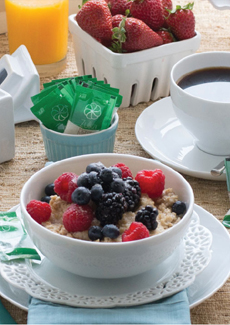|
It’s National Breakfast Month and we have a “public service announcement” on healthy breakfasts. You’ve heard it before, but if you’re not convinced that you’re eating the best breakfast you can, read on.
More than 100 studies have linked eating breakfast with a reduced risk of obesity (and other health benefits, including diabetes and heart disease) and a mental edge—enhanced memory, attention, the speed of processing information, reasoning, creativity, learning, and verbal abilities.
Just be sure that you don’t blow your entire daily quota of added sugar on breakfast (more about this in a minute).
Healthcare professionals recommend a breakfast that combines good carbs and fiber with some protein. On the list:
Cottage cheese: Enjoy it plain (try some cinnamon or cracked pepper), with fruit, yogurt, or as a bread spread.
Eggs: A good source of protein, research has shown that the cholesterol in the yolks has less of an impact on blood cholesterol than previously thought. You can buy peeled, hard-boiled eggs for grab-and-go, or make your own. We poach eggs in the microwave in under a minute (the technique is below).
Cold cereal: Bran or whole-grain cereals (such as shredded wheat) are your best bet. Look for a product with less than 5 grams of sugar and at least 5 grams of fiber.
Fruit: Add bananas, berries, dried fruit, grapefruit, melon or other favorite. Enjoy it with cottage cheese and/or plain yogurt.
|
|

Don’t buy pre-sweetened cereals. Add your own sugar, honey or noncaloric sweetener, so you can control the amount. Photo courtesy Zulka. |
|
Greek yogurt: It has nearly twice as much protein as regular yogurt. Instead of sugar-laden flavors, add fruit and a light sprinkling of sugar, honey or noncaloric sweetener to plain, nonfat yogurt.
Oatmeal: Ideally, make steel-cut oats, which contain more fiber than rolled or instant oats. They take longer, but you can prepare a large batch and reheat individual portions each morning. Any type of oatmeal except the flavored ones is a better-for-you choice. Avoid flavored varieties, which are packed with sugar. Instead, sprinkle a teaspoon of sugar or a bit of honey on plain oatmeal, and add fruit for natural sweetness (plus nuts for added protein).
Peanut Butter or almond butter: These are excellent sources of protein. Spread them on whole grain bread.
Spreads: Butter and jam just add empty fat and calories. If you need a bread spread, consider almond butter, peanut butter, cottage cheese or Greek yogurt.
Whole grain bread: This is an easy switch. Whole grains products—in bagels, bread, crackers, English muffins, whatever—contain more fiber and nutrients than refined, white flour products.
Healthful add ons:
Sprinkle your cereal, cottage cheese or yogurt with wheat germ or ground flaxseed.
Add a banana—a healthful carbohydrate that keeps you feeling fuller longer.
|




